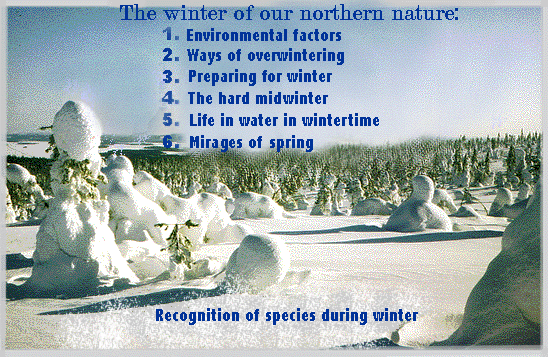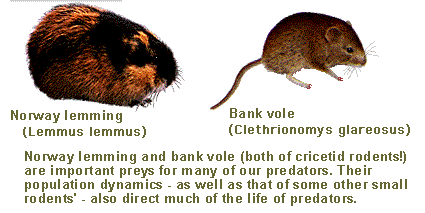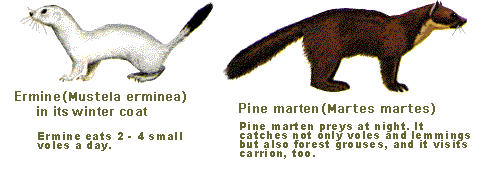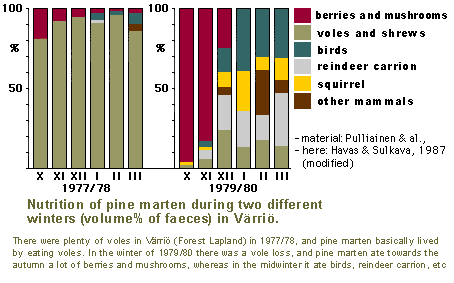Preying in winter is often particularly difficult...
Many beasts of prey find it difficult to move in soft snow. See more: Moving in the snow!
There are fewer preys in winter than in summer. Migratory
birds and animals in winter torpor are not available in winter, and
other preys die of cold and hunger. In a bad vole year also many
predators (e.g. owls) die, and in spring their nesting fails to happen.
The shortness of a winter day limits the hunting time of the diurnal predators.
Some preys can hide into the snow. Small mammals are almost always under the snow, forest grouses rest in their snow coils, and titmice look for food hiding behind the crown snow-load of the trees. Weasel is the only predator that fits into
the snow tunnel of voles. Some voles make holes from their tunnels to
the surface of snow and frequently peek out of them. Owls and also some
other birds of prey have learned to catch the voles from these holes.
Different predatory mammal species may prey around the same area even if they mainly prey for the same animals (e.g. small mammals). However,
the male ermines, for instance, do not let other males into their
territory, nor do the females let other females into theirs. (The
diameter of a territory may be about 1-2 km, female's territory being a
bit smaller.) Pine marten moves around in a winter night about the amount of 5 km when looking for food. The winter ecology of pine marten has been extensively studied in Lapland, Värriö Research Station
(in Savukoski, in the area of Forest Lapland). In Lapland in a bad vole year pine marten eats a variety of food. At least in Lapland pine marten's diet varies depending, above all, on vole situation (check the picture!).
• The invertebrate are suitable for food for many...
In winter many birds as well as shrews eat insects and spiders in their winter torpor. Birds find them mainly from trees, whereas shrews from the ground under the snow. See more: Insect nutrition in winter!
• The far-sighted use their own food stock in winter...
Many winter active animals collect food for winter. See more: Food stocks!
However, not all food stocks collected during autumn can be found. The problem is often with animal's memory: one cannot always remember all the hidden stashes... Squirrel, for instance, has many winter stashes,
but it still remembers extremely well the locations of its stocks! The
same applies to nutcracker and jaybird (who stocks acorns in southern
Finland). Water vole does not have these kinds of problems because its stocks
are located in its own tunnels. Also flying squirrel and pygmy owl
collect their fairly big stocks into just few holes where it is easy to
find them.
The stocks can also be coated with snow so that the animal cannot find them. Titmice stock
their food in trees to a certain height where they usually stay so that
they can find their stocks more easily. Willow tits and crested tits
collect mainly vegetable food into their stocks although in summer they
eat mostly insects. Squirrel, on the other hand, has to look for its
stashes from completely different places (usually ground) than where it
usually stays (trees).





